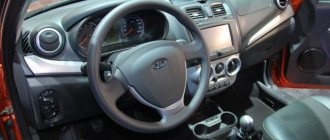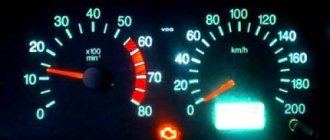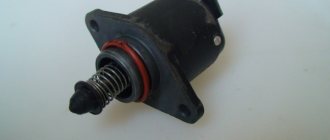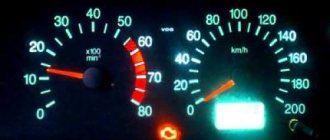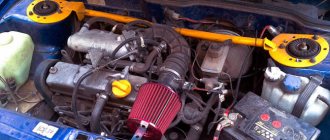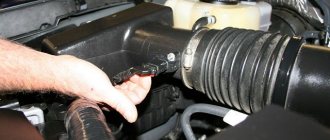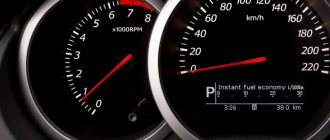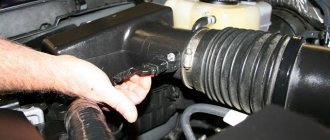Intake system leakage
Air must enter the engine only through the intake manifold. If the intake is damaged, air is sucked in from outside. Because of this, when starting the engine, the speed fluctuates, the engine does not hold speed at idle at all (stalls), and in some cases it is simply impossible to start. Air leaks in different places:
- through the walls of the collector (a common “disease” of plastic collectors in which microcracks form);
- through vacuum hoses;
- in the connection of pipes and hoses.
Intake manifold
If the collector is not damaged, but the “idles” begin to float, it is worth inspecting the gasket. Over time, it dries out and allows air to pass through. More “unaccounted” oxygen enters the cylinder - the mixture becomes lean, the internal combustion engine stalls. The situation is the same with the throttle valve gasket - the engine suffocates and does not hold speed at idle.
We carefully inspect the air pipes. Due to frequent and large temperature changes, rubber tubes dry out and crack. Why do engine speeds start to fluctuate? Air “unaccounted for” by the sensors again enters the combustion chamber, which leads to a situation similar to the previous one.
Air pipe
The engine may stall due to damaged vacuum hoses. Since they serve to transmit vacuum, the ingress of excess oxygen will instantly affect the operation of the car.
If your car has a gasoline vapor adsorber, inspect the valve. This is a common disease in domestic cars.
Canister valve
It is a faulty adsorber valve that causes the engine to go crazy. Replacing the valve helps eliminate the vibration problem at idle.
Common places for air leaks
- Loose clamps on pipes and vacuum hoses.
- Cracks in rubber hoses and pipes. Most often found near clamps, in places of contact with elements of attachments.
- Broken brake booster diaphragm.
- Leaking vacuum valves (PCV, EGR, absorber purge valve). The cause of the leak is a leaky membrane, but cracks in the housing should not be ruled out. If your car is equipped with HBO, check the vacuum corrector.
On Japanese-made cars, when troubleshooting, pay attention to the system of vacuum valves involved in adjusting the warm-up speed and opening the additional air channels.
- A crack in the plastic intake manifold due to a manufacturing defect or mechanical damage. Often such collectors consist of several elements assembled on sealing gaskets. If the gaskets become tanned due to temperature loads in the compressed state, air will be sucked into the intake manifold through them.
- Loose fit of the intake manifold to the cylinder head.
- Worn or incorrectly installed fuel injector O-rings.
- Wear of the throttle valve rotation axis in the housing (very common on Mitsubishi Lancer 9).
Idle speed control
The mechanism serves to maintain engine speed when the throttle valve is closed. The malfunction manifests itself in different ways: the car stalls, troits periodically, or constantly cannot go to idle.
Idle speed control
If you notice floating engine speeds, there are several reasons for the malfunction:
- Poor contact. The valve just doesn't seem to have any power. You need to inspect the wire terminals - often the terminals become oxidized and become covered with dirt.
- Dirt under the stem. If the regulator is disassembled, there is a chance to clean it - after reassembly, the problem goes away.
- Lack of lubrication in the rod. After lubrication, the valve operates normally.
When choosing a new regulator, it is advisable to avoid unknown manufacturers. Often such parts fail within a week, especially on Russian cars. If possible, try to purchase original parts.
Carburetor internal combustion engines
Here the vast majority of reasons lie in the dosing device itself. High idle speed in this case is due to:
- Incorrect idle speed setting. It is necessary to adjust the composition of the mixture supplied to the carburetor using the appropriate screws.
- A jammed air damper: if it does not open completely, little air will flow into the cylinders.
- The shutter of the 1st chamber. It may not close completely due to a mechanical defect or an incorrectly adjusted actuator.
- Fuel level in carburetor float chamber too high
Ignition system
The reason for floating speed may lie in a damaged ignition distributor cap, high-voltage wires or spark plugs. These elements should be checked and replaced if necessary.
It is also worth noting completely banal reasons that are typical for both types of engines: incorrect adjustment of the accelerator pedal drive and jamming of the accelerator pedal itself, associated with corrosion of the mounting shaft and spring due to the car being idle for a long time.
Idle jet
If you have a carburetor with variable speed, inspect the jets. If dirt gets into them, the mixture becomes lean and the engine runs unstably.
Carburetor jet
Unscrew the solenoid valve and remove the XX jet. Using carburetor cleaner, wash off dirt, dry and reinstall. By the way, sometimes the reason lies not in the jet itself, but in the o-ring. After replacing it, the engine works properly.
Typical symptoms of a breakdown
First of all, the tachometer will help determine the breakdown. You can see the problem that has arisen in idle mode. During normal operation, even a slightly warmed-up engine at idle will maintain the usual indicator on the tachometer - 800 rpm.
The situation can change only when the warm-up speed is XX. In this case, the speed rise is carried out independently by the ECU in the range of 1000 - 1100. When the temperature of the internal combustion engine begins to increase slightly, the unit independently lowers the idle value to 800.
If problems arise in the functioning of the engine, the speed value will begin to drop significantly, and then increase again (for example, at first the indicator may sharply drop to 500, and then at the same minute increase to 800 or higher, and again drop sharply).
Sometimes intermittent phenomena can be seen when the load on the internal combustion engine increases. Floating speeds are noticed when driving in transition mode. If there is no additional load on the engine, it is able to maintain a stable speed. But when even a small load appears, the indicators begin to fall rapidly.
If the driver does not have a tachometer, then the presence of floating speed can be determined by the appearance of a specific sound. Since the internal combustion engine produces the same sounds and noises at a stable load, when it changes, acceleration may fail, and vibrations also change. Sometimes there is a situation when the engine starts to stall.
Another no less characteristic sign is an increase in fuel consumption, engine response changes, and dips or jerks in acceleration are observed.
Crankcase ventilation valve
The mechanism removes gases from the crankcase into the combustion chamber through the intake manifold. Why does the speed fluctuate due to dirty ventilation? If the valve is clogged or does not open well, the pressure inside the system increases. Crankcase gases enter the combustion chamber in excess quantities. The malfunction can be noticed by traces of oil that is squeezed out of all seals and gaskets. If the engine speed begins to fluctuate, by cleaning or replacing this valve, the problem disappears.
Crankcase ventilation valve
It is important to know! The operation of the internal combustion engine is affected not only by the valve itself, but also by the condition of the ventilation system pipes.
They should be elastic and free of cracks. If the tube bends like plasticine and does not return to its original shape, we urgently replace it. This means that there is a critical layer of soot inside it.
Dirty crankcase ventilation pipe
The ventilation system is the “lungs” of the engine. By eliminating blockages, engine operation is stabilized in all aspects - speed is leveled, consumption is reduced, and the car picks up speed more easily.
Injector
Here everything is much more complicated: the operation of an injection engine is associated with many sensors, ECUs and other elements of the power unit, in particular the fuel system. But first things first.
Idle air control sensor (IAC)
If this device is faulty, the engine may stall at idle, or its speed will float, making jumps in the range of approximately 600-1200 rpm. Therefore, it is necessary to ensure that the device is working properly. This can be done using a multimeter. Procedure:
- First, measure the supply voltage on a pair of outer terminals A and D. To do this, place the black probe of the device to ground (any unpainted metal part of the car body), and the red one to the indicated terminals in turn. When the ignition is on, there should be 12 V. If this is not the case, check the voltage at the ECU terminals (for the VAZ 2110 these are pins 4 and 54). If there is 12 V here, look for an open circuit in the wiring.
- Set the tester to ohmmeter mode. Resistance between terminals A and B, C and D: should be 40-80 Ohms.
- Check the motor for short circuit. To do this, measure the resistance between A and D, B and C: the arrow of the device should tend to infinity.
TPDZ
That is, a throttle position sensor, which is responsible for the amount of fuel mixing with air. If the fuel supply is incorrect, the ECU will automatically give a command and the idle speed will increase. Therefore, it is necessary to check the TPS:
- Unclip the connector that fits the sensor: you will see 3 contacts: for the control signal, power and ground.
- Start the engine and measure the voltage at the power terminal: it should be approximately 5 V.
- Stop the engine and switch the tester to resistance measurement mode (throttle valve closed). Measure it between ground and signal contact: it should be 0.8-1.2 kOhm. When the damper is closed, the value is 2.3-2.7 kOhm.
How to remove and install a new sensor
To dismantle, simply unscrew a couple of mounting screws. Next, disconnect the end of the damper shaft and, rotating the new sensor, align the holes to screw in the screws. Put the connector on.
After completing the work, it is necessary to delete the error from the controller’s memory. To do this, remove the terminals from the battery for a period longer than 8 hours. If the error has not cleared, try driving in a gentle mode so that the ECU resets it itself. If you fail again, you will have to contact a car service (you will need a motor tester).
Throttle valve
Jamming of this mechanical device will result in an increase in the amount of air supplied to the cylinders. As a result, the ECU will work again and begin to increase the volume of fuel to balance the mixture. To solve the problem, remove the damper and clean it with chemicals. If there is no result, the part will have to be replaced.
Engine temperature sensor
As practice shows, this device breaks down quite often, because it is constantly exposed to temperature changes. It needs to be checked:
- Disconnect the block and with the ignition on (no need to start the engine), check the voltage at terminal “B” relative to ground: it should be 5 V. If the value is less than 4.7 V, you need to look for the reason: a break or short to ground is possible.
- Turn off the ignition and determine the resistance between contact “A” and ground: the correct value is 1 Ohm (no more and no less).
- Measure the resistance between ground and terminal “B”: it should be at least 1 Ohm.
- Check the functionality of the sensor. To do this, you need to measure the above resistances on a cold and warm engine. The values must be the same.
After the checks, it is recommended to reset the ECU errors, as indicated above in the section on TPS.
Mass air flow sensor (MAF)
During operation, this device gradually becomes covered with an oil film, which can lead to failure of the hot-wire anemometer, the element responsible for determining the amount of air. If the device does not cope with its task, the ECU receives incorrect information and the engine begins to increase speed.
Increased speed may also be due to a dirty air filter.
Intake manifold
It may have deformation or gasket breakdown. An increase in idle speed indicates an air leak.
To fix the problem you will have to remove the manifold. After dismantling, inspect it carefully: deformation can also affect engine warming up, its starting and other factors. Damage is eliminated by grinding, which is preferable to do in a car service center.
Electronic engine control unit
Incorrect operation of the ECU also affects high idle speeds. To restore the normal functioning of the “brains” you will need a special cable, computer and software.
It is highly not recommended to poke around here on your own: it is better to trust the specialists. In practice, after unprofessional intervention, the “do-it-yourselfers” still have to go to a specialized technical center to eliminate the consequences of their own “improvements.”
Generator
Although rare, it can also cause increased engine speed at idle. Why is this happening? If this unit does not produce enough current, the ECU will command the engine to spin up more strongly to bring the voltage up to normal. As a result, the turnover will increase.
Crankcase ventilation (PCV) system
It is needed to remove crankcase gases through a special valve in order to prevent pressure from increasing above normal.
If you can find the PCV valve, then carefully pinch the tube that fits it with pliers: when the engine is running, the speed should drop slightly. If this does not happen, the device must be replaced.
Turbocharger
Not all cars are equipped with such a “thing,” but it may be the “culprit” for high engine idle speeds, which can “automatically” decrease and increase. Air leaks may occur here due to a leak in the rotor shaft gasket. The same effect can be caused by wear of turbocharger parts (for example, bearings).
We recommend: Why does the engine stall at idle? Possible causes and action plan
Air flow sensor
It is located between the throttle valve and the air filter. The sensor determines the volume of air passed through and sends information to the ECU. The latter adjusts fuel injection based on its data.
Mass air flow sensor
Inside the mass flow sensor there is a temperature compensation resistor, which often fails. Because of this, the sensor incorrectly determines the volume of oxygen, and accordingly, the control unit makes incorrect corrections. In some cases, you can get by with cleaning the sensor, but often it has to be replaced entirely.
Owners often fell for low-quality sensors. An original mass air flow sensor can cost 10 thousand rubles or more.
Therefore, there is a temptation to buy a cheaper analogue. But after installing it, the problem does not go away (or it goes away, but not for long). And only with a new original sensor the unit receives the correct information.
Popular brands:
Mercedes-Benz GL-Class
Why do the revs fluctuate on a cold diesel engine?
Starting a diesel engine in frosty weather is often complicated by the fact that diesel fuel has a higher thickening point than gasoline, so often in severe frosts it is simply difficult to pump through the fuel system. And accordingly, after starting, there may also be problems with the normal operation of the engine in different engine operating modes, including floating idle speed.
Other reasons why the idle speed of a diesel engine fluctuates when cold:
- Partial failure of the high pressure fuel pump (HPF). However, it is worth noting here that if the specified pump breaks down, the speed will fluctuate not only “cold”, but also “hot”. Usually the pump simply wears out, or is subject to corrosion or mechanical damage.
- Crankcase gas recirculation (EGR) system. If the USR valve is clogged, it may jam, which will automatically lead to a decrease in engine power and unstable engine idling.
- Malfunction of engine sensors, in particular, we are talking about the mass air flow sensor. As with gasoline engines, when the sensor fails, it transmits incorrect information to the ECU, and therefore the control device cannot set constant speed, including at idle.
- Air leak in the fuel supply system. In turn, this occurs due to depressurization of the fuel lines, for example, at the joints, damage to the seals, and so on. Due to the airiness of the fuel system, the high-pressure pump cannot pump up the pressure necessary for normal engine operation, and the speed begins to “float”, especially at idle, when its value is low. When the engine speed increases (in particular, after the engine warms up), the operation of the power unit improves.
- Clogged air filter. In such a situation, the engine will not have enough air, and accordingly, at low speeds the engine will operate unstably, both “cold” and “hot”.
Conclusion
Usually, increased and even floating speeds when starting the engine “cold” are allowed during the first few seconds of engine operation. If so, there is nothing to worry about. However, if the revolutions fluctuate for a long enough time and at the same time the car (engine) also vibrates, then this is a reason to perform diagnostics. First of all, you need to start by checking for ECU errors, and if there are any, check those components and assemblies with which they are connected. Also perform several manipulations to identify possible air leaks.
Throttle valve
The idle operation of an injection engine also depends on the throttle valve. Over time, it becomes covered with soot, which is why it does not close completely. This usually happens after 100–150 thousand kilometers. More oxygen enters the combustion chamber, causing the idle speed to fluctuate. The problem can be solved by dismantling and thoroughly cleaning the mechanism.
Dirty throttle valve
Why should this work be trusted to specialists? Often, after cleaning it yourself, the problem does not go away - the motor vibrates, and even the “Check” lights up. The fact is that on modern cars you need to adapt the damper after cleaning. An adapter with CAN support is used for this.
How to stabilize floating speed
- Penetration of foreign air into the engine . It is necessary to check the tightness of the air system channels with the intake manifold. For such purposes, it is necessary to dismantle each hose separately and pump it with a pump or compressor, but you can try spraying liquid -40 on the hoses, where it will quickly evaporate; there is most likely a crack in the hose. In such a situation, it is better to replace the damaged hose with a new one rather than wrap it with electrical tape.
- Replacing the IAC . The condition of this device is checked with a conventional multimeter, which needs to check its resistance. If the resistance readings are in the range of 40-80 Ohms, the regulator is faulty and such a device requires immediate replacement.
- Cleaning the valve and elements of the engine ventilation system . In this case, you will have to disassemble the oil sump and get to the ventilation valve. It should be pulled out and washed in a product for cleaning engine elements from an oil film. You can use regular kerosene. Next, dry the valve thoroughly and then put it in its place.
- Replacing the air flow sensor . This is the most delicate part and most often cannot be repaired. Therefore, if the cause is the air flow sensor, then it is advisable to replace it. It is known from practice that even professionals cannot repair a hot-wire anemometer.
- Flushing the throttle valve and then installing it in the correct position . There are two methods for cleaning the throttle valve from oil contaminants: without removing it from the car, and also with removing the throttle valve. When removing the damper from the car, you must disconnect all wires and hoses from the damper, loosen it and pull it out. Next, place it in a container and fill it with cleaning aerosol. If the oil stains on the surface of the throttle valve are already old, you can clean them with a brush. Next, dry the damper surfaces with a rag and put them in place, connecting all the wires and hoses. If the damper is not removed from the car, then it can be washed on a hot power unit with a similar aerosol. Before spraying cleaning agent, disconnect power from the throttle valve. First you need to pour the product inside the throttle valve, wait a few minutes and start the engine. With the power unit operating, continue cleaning the damper with the same product. If, during such cleaning, white smoke comes from the damper, then this is normal, since oil contaminants are cleaned in this way. At the end of the work, you should connect the wires and adjust the operating order of the throttle valve on the computer, setting the required opening gap.
- Idle speed adjustment . This procedure can be carried out using a regular screwdriver, adjusting the screws for the quality of the fuel mixture and the number of engine revolutions.
- Replacing the solenoid valve . If the carburetor idle valve malfunctions, the engine can only operate when the choke handle is pulled out. Therefore, in order to prevent idle speed fluctuations, it is advisable to replace the valve with a known good one or a new one.
- Cleaning the idle air jet . Even in the old days, cleaning the jet from oil deposits was considered a very labor-intensive task. Currently there is no need to remove the jet from the carburetor. To do this, you just need to pour a specialized product into it, designed for cleaning carburetors, and wait in this state for several minutes. Then you need to clean the nozzle from dirt using compressed air.
- Treatment of parts of the fuel pump on a diesel engine from rust . To perform this task, you will need a specialized corrosion cleaning agent. This can be either an imported or a domestic product. It is simply sprayed into the fuel tank by opening its neck before refueling with diesel fuel at a gas station. The cleaning agent will clean the pump parts from rust on its own. In order to prevent similar corrosion of the high-pressure pump in the future, it is recommended to pour a glass of motor oil into the tank, which can form a protective film on the surface of the pump parts when moving.
You need to know that if uneven engine speed occurs at idle, you must immediately contact a service station and carry out detailed diagnostics of the operation of all engine systems. Timely detection of faults will protect you from costly repairs.
Injector malfunction
With mileage, the injectors become dirty, causing them to spray fuel incorrectly. This is immediately noticeable in the behavior of the car - consumption increases, power drops, the car starts poorly and does not idle.
Cleaning injectors
Often owners try to solve the problem the easy way by pouring some additive into the tank. But no matter how expensive the additive is, it will not give the same effect as ultrasonic cleaning on a stand. Yes, to do this you need to remove all the injectors. But the result exceeds all expectations - the corrections return to normal, the speed is equalized, and the consumption decreases.
Carburetor engine
On carbureted cars, the carburetor is almost always at fault.
Among the huge number of reasons causing idle instability, the main ones are:
- Unregulated idle mode, lean mixture.
- Solenoid valve defective. This is evidenced by the engine running only on suction.
- The jets and idle passages are clogged. The mixture lacks air.
- It is sucked in and the mixture becomes leaner, as a result of which the engine stalls if the choke is not pulled out.
In this case, the temperature of the fuel at the end of the compression moment should not exceed this value of fuel ignition.
Spark plug
The quality of ignition of the mixture directly depends on their condition. If at least one of the spark plugs is faulty, it will be immediately noticeable by terrible vibration and unstable speed. There may be several reasons:
- the life of the spark plug has been exceeded (for conventional ones it is 20-30 thousand kilometers, for iridium ones – 100);
- the gap between the electrode is increased;
- the electrode is covered with carbon deposits, which prevents a spark from breaking through.
Spark plug with oil deposits
If the spark plugs are covered in oil soot, you need to “dig” towards the valve seals and piston rings. The former require replacement after 150–200 thousand kilometers. But with rings the situation is individual. It happens that they become coked after only 100 thousand, but with timely maintenance there should be no problems with the rings for at least 250 thousand kilometers. Oil also leaks due to a clogged crankcase ventilation system, which we talked about earlier. If the spark plug is filled with gasoline, check the injectors and sensors.
Replacement
To replace the XX regulator, you do not have to be a professional. By doing the work yourself, you will gain a rewarding experience and can also save a fair amount of money.
The entire procedure must be carried out in strict sequence, which will allow everything to be done correctly and efficiently. Maybe even better than at a service station.
- Unplug your car. To do this, simply remove the negative terminal from your car's battery. We don't need short circuits or electric shocks.
- Disconnect the connector from the sensor. In the case of an injection engine installed on your VAZ 2110, to disconnect the pad you just need to press the plastic latch.
- Remove the two screws. Moreover, it is better to unscrew the left fastener first, and then the right screw.
Removing the device
- This will allow you to achieve what you want - remove the idle air control. Further operations are simple, like all previous activities.
- Before installing the new sensor in its rightful place, use regular engine oil to treat the O-ring.
- Inspect the condition of this same O-ring. During prolonged use, the seal may become deformed and become cracked. In this case, it is better to replace it with a new one.
- Next comes the calibration stage. You won’t have to make any serious efforts, since the electronic relay will take care of all the main calibration tasks.
- Turn the ignition on for a few minutes and then turn it off.
- If after the operations and calibration the revolutions stop floating, they are not increased and stable, you did everything right, and it was the XX sensor that was to blame.
As you can see, IAC is a fairly important element in the car system, which must be carefully monitored. A pleasant fact is that if troubles arise with the regulator, you can always replace it with your own hands in a matter of minutes.
The ability to implement feedback is an advantage of electronic fuel injection systems and their fundamental difference from other power systems of internal combustion engines. In this case, we are talking about controlling the mixture composition and directly regulating the engine operating mode itself - the injection ECU can either adjust the speed in a certain range (cars with a “mechanical” throttle) or control them (an “electronic” throttle).
However, situations are possible when the ECM is not able to support the desired mode. One of the characteristic symptoms of this is the “swimming” of revolutions, their constant change with clearly defined periodicity.
Reduced fuel pressure
Let's look towards filters. There are two of them - coarse and fine cleaning. The first is located in front of the pump, the second is behind it.
Filters need to be changed every 30 thousand kilometers.
It is important to check the vacuum regulator valve in the fuel rail. It causes problems when driven over 200 thousand kilometers. There is a more serious problem - the pump is faulty. It may turn on, but not produce the required pressure. By measuring the outlet pressure, conclusions can be drawn. Note that the pump often burns out when driving on an empty tank, as it is cooled by the fuel itself. To avoid having to replace the pump in the future, keep the fuel level at least 1/4.
Low pressure in the fuel rail.
Another reason when there is no idle, or poor idle and the car jerks and drives poorly is insufficient pressure in the fuel rail. The pressure must be measured using a pressure gauge, cutting into the fuel line where the fuel rail and the line from the fuel pump meet.
What pressure should be in the fuel rail? Here it is already necessary to look at the manual for this car, since in many cars the pressure in the fuel rail is different.
I have met many craftsmen who repair cars at random, that is, by replacing everything in a row, by elimination. But you just need a correct and logical approach, and it wouldn’t hurt to understand how injection engines work. Agree - it’s easier and cheaper to measure the pressure in the fuel rail than to immediately change the fuel pump. I think it won’t be difficult to find a guide on exactly what pressure should be in your car. It is very easy to measure the pressure and rule out or judge the fuel pump to be faulty. So before spending money on buying new parts, always properly diagnose a particular part first.
Instability of speed in intermediate modes
A problem typical for diesel cars. The reason is rust on the injection pump plunger. This happens due to water getting into the tank (possibly due to simple condensation).
Rusty injection pump plunger pairs
The consequences are high fuel consumption, exhaust smoke and increased wear of the fuel injection pump. To prevent this, many people install separators in the fuel system. This “sump” retains not only water, but also various impurities that may be in the tank.
Excess fuel supply
Cleaning the throttle body
A completely different situation will arise if not just excess air, but an air-fuel mixture enters - for example, through a gap formed as a result of loose closing of the throttle valve. In this case, the high idle speed of the engine will be stable. The fuel systems of some engines provide semi-automatic control of the fuel supply during engine warm-up mode - due to this, high idle speeds are maintained until the engine warms up to the set temperature. Fuel is supplied through a channel that bypasses the throttle valve. Such a channel can be closed/opened in various ways - the valve in it has either an electric drive (solenoid), or it can be arranged like a refrigerator thermostat - when the engine warms up, the channel is locked.
At high idle speeds, you should check the entire throttle valve assembly with sensors and idle control.
In any case, such a valve may break, and then excess fuel will always flow into the intake manifold, which will cause high idle speeds after the engine has warmed up. In all such cases, first of all, you need to remove the throttle body and wash it with a special solution - there are a lot of similar “chemicals” sold in stores. After washing, you need to carefully inspect the assembly - especially for sticking or, on the contrary, excessive looseness of the throttle valve. The throttle valves of some injection engines also have a screw for adjusting the idle speed of the engine or limiting the closing of the valve - you should also pay attention to them - whether the unit can be adjusted. Often, the engine speed does not drop at idle due to the gas cable getting stuck or foreign objects getting under the pedal - the corner of the mat, for example. Of course, almost all of the above can also apply to carburetor engines. In addition, a typical malfunction (or, more precisely, a deviation from the norm) for them is incomplete opening of the air damper - mainly due to incorrect installation of the choke cable. In the absence of breakdowns, the normal idle speed of a carburetor engine is set by adjustment using two screws - the “quantity” and “quality” of the mixture.
Low compression in cylinders
If the compression test shows a disappointing result, the engine will need to be repaired. Compression drops for various reasons:
- Burnout of the cylinder head gasket. In this case, the oil breaks into the expansion tank, the antifreeze level drops, and there is “mayonnaise” on the dipstick. The gasket burns out due to improper assembly of the cylinder head after repair, due to overheating or impaired fuel combustion in the cylinder.
- Faulty hydraulic compensators or incorrect valve adjustment. This can be determined by a characteristic metallic knock. You can’t drive like that - you can quickly “sentence” the camshaft.
- "Standing" of piston rings. At the same time, the grooves of the piston rings become coked. This happens with infrequent maintenance, using low-quality oil and during short trips without load.
- Cylinder scuffing. This happens on old engines with a mileage of 250-300 thousand kilometers. Seizures can occur ahead of time due to overheating, using bad oil, or driving with low oil levels. On engines with a clogged USR, all deposits enter the combustion chamber, where they act as an abrasive, lifting up the hone.
The reasons for floating idle speed can be different and appear only in certain modes. But in any case, this should not be considered the norm. The sooner the problem is identified, the easier and cheaper it is to make repairs. Keep an eye on the condition of your car, and it will reciprocate!
Why do the revs fluctuate when cold?
Common causes of jumping revolutions
First, let's look at the main causes of this malfunction for injection engines, since most often this is where this problem occurs. In addition, most of the faults listed below will occur on engines of any type of fuel supply.
Atmospheric air suction
Air intake in the intake manifold can cause the speed to fluctuate both “cold” and “hot”. Air can enter the engine not only directly through the intake manifold, but also through cracks in the elements of the air system. For example, through the walls of the manifold (very important for manifolds with a plastic body), leaking vacuum hoses, places where hoses or pipes are connected. It often sucks air in the place where the throttle valve meets the manifold.
Since the question is why a cold engine does not maintain speed, but when warmed up everything returns to normal, then in this case it is worth remembering ordinary physics. It’s just that as it warms up, all the elements under the hood warm up, which is why their bodies expand and air, if at all, is sucked in, then to a lesser extent. Consequently, the speed levels out and no longer fluctuates.
Typical parts in the intake tract through which air leaks usually occur:
- Intake manifold gasket. Like most gaskets, it hardens and dries over time. Accordingly, air begins to penetrate through the manifold, which is not taken into account by sensors (in particular, mass air flow sensor, DBP and others). Due to excess air in the system, the engine begins to “suffocate” and eventually stalls.
- Gasket on the throttle valve. The throttle valve itself is designed to control the amount of air entering the engine. Therefore, if it allows excess air to pass through (in particular, through the gasket), the engine will also experience a loss of power.
- Pipe from the air filter to the throttle body. The situation is similar here. The volume of incoming air is clearly controlled by sensors. If excess air enters, the engine speed will “float”.
- O-ring of injectors. On injectors that have been in use for a long time, the O-rings become unusable over time. Accordingly, unaccounted air, which is superfluous, enters the combustion chamber through them. This leads to a drop in engine power and to the fact that the speed fluctuates when cold. When the injector rings themselves and the engine are cold, they are smaller in diameter, and then, as they warm up, the rings soften and acquire a normal diameter, so the speed stabilizes.
- Vacuum brake booster. In this case, depressurization of both the VUT itself and its hose with a vacuum valve, which communicates with the intake manifold, is possible.
- Vacuum hoses in the air duct system. Depending on the design of a particular engine, the number, size and location of hoses will vary. However, in any case, since vacuum hoses are designed to transmit vacuum, the entry of air into them will have an incorrect effect on the operation of the engine as a whole.
- Canister valve. The solenoid valve of the adsorber is designed to purge it. The valve is controlled by an electronic control unit based on information from a large number of sensors, which can also be the “culprit” of the breakdown. However, in any case, when the adsorber valve exits, a situation arises when the adsorber is not purged and a “clog” occurs in the system.
- Idle speed regulator. This unit is designed to maintain idle speed with the throttle valve fully closed (via the bypass). If it fails, then when the throttle is closed the engine will simply stall. If the regulator is unstable, then the engine speed will “float”.
In carburetor cars, air leaks may still occur in the following places:
- Fuel mixture adjustment bolt. If it is damaged or incorrectly configured, it is possible that when the engine is cold, an air-fuel mixture with suboptimal parameters will form in the carburetor.
- Gasket under the carburetor. If it is damaged or simply aged, it can allow external air to pass through it, which will also result in the formation of an air-fuel mixture that is unsuitable for “cold” mode.
- The throttle valve, if it does not fit tightly into its seat. If on injection engines the damper is driven by servo drives, then on carburetor cars the damper is usually driven mechanically - through a metal cable. Therefore, the cause of a loose fit can be either a dirty valve or problems with the cable. For example, its contamination, damage to the shirt, the appearance of dirt or rust on it.
- Throttle axles. If they are dirty or damaged, the normal operation of the throttle is disrupted. Accordingly, idle speed failure is possible in various engine operating modes, including cold.
- Throttle damper diaphragm. Its task is to deplete the air-fuel mixture to optimal levels. If it is damaged (cracks, aging), air may leak. The result will be similar - unstable speed in different engine operating modes.
- Solenoid valve. Its main task is to reduce engine fuel consumption. This is achieved by the valve closing the channel through which the air-fuel mixture is supplied. If the valve is completely faulty, then its needle will completely block this channel and the engine will simply stall. If the solenoid valve is only partially out of order, then the engine speed, including when cold, will be unstable.
Low fuel pressure
For the same common reason as air leaks, the engine does not idle when cold due to low pressure in the fuel system. In turn, this may be caused by the following reasons:
- Dirty fuel filter. Moreover, both the main fuel filter and the mesh on the fuel pump of injection machines can be contaminated. Dirt in the filter does not allow fuel to pass through, which causes “starvation” and unstable speed in different engine operating modes.
- Fuel regulator. If it fails completely, the engine will most likely stall completely. If it is partially broken, then the speed will “float”, including when it is cold.
- Gasoline pump. This applies to both carburetor and injection engines. In the first case, the problems will only be of a mechanical nature. In injection fuel pumps, the blades may wear out, the bearings may fail, and the electrical wiring may be damaged.
- Low compression. It is also possible to have different compression for different cylinders. This is especially felt in the cold, when in the cold the cylinders slightly decrease in size, and after warming up they increase, and accordingly, the compression increases.
- Uneven fuel supply to the cylinders. There are various possible reasons for this. Starting from dirty injectors and ending with a failure in the ignition system. For example, misfires may occur.
- Mismatch between injection timing and spark supply. As a rule, the cause of this is the crankshaft position sensor. However, the idle speed will be unstable not only when cold, but also in other engine operating modes.
Idle speed control
If it partially fails or becomes dirty, it may jam and, after starting the engine, not immediately set the required speed values. IAC jamming is possible in both cold and warm weather.
In general, the idle air control is designed to adjust (increase or decrease) the supply of fuel to the combustion chamber. The device operates on the basis of a needle and a rod. It turns on when the engine is idling, that is, at low speeds. One of the signs of a malfunctioning idle speed control is the fact that the engine may run normally under load, but stall at idle. Likewise, the driver is forced to apply gas while starting the engine. If the IAC is faulty, the idle speed may change as the load on the engine (battery) increases. In particular, when turning on external lighting, air conditioning, climate control systems and other consumers.
Engine sensors
A modern injection engine is equipped with a large number of sensors, and accordingly, if many of them fail, it can lead to a problem like idle speed floating on a cold engine. According to practice, the “culprits” for such a situation are most often:
- throttle position sensor (TPS);
- mass air flow sensor (MAF);
- absolute air pressure sensor (DAP);
- manifold inlet air temperature sensor (DTVV);
- engine temperature sensor.
The sensors listed above in some cases (in case of complete or partial failure, for example, as a result of aging/wear) under critical operating conditions may provide incorrect data to the electronic engine control unit. And accordingly, the ECU will issue signals due to which the revolutions fluctuate greatly when cold. Moreover, both damage and ordinary contamination may occur.
If the temperature sensor is damaged, often after the first attempt to start the engine, it stalls if you do not pick up the speed with the accelerator pedal. After the second start, the engine usually works normally, but the speed fluctuates. They then drop from 1000 rpm to approximately 700...800 rpm, after which they “jump” above a thousand and fall again. This can continue until the engine is more or less warmed up.
This happens because if the electronic control unit “sees” that incorrect information is being received from the sensor or that the signal is not being received at all, then its algorithm is designed in such a way as to go into emergency mode. In this case, instead of a signal from the sensor, the ECU takes averaged data for calculations, and at the same time generates an error in memory. For example, if the engine temperature sensor fails, then instead of the data from it, the ambient air temperature will be taken into account. Accordingly, until the engine warms up, the speed will “float”. Moreover, the colder it is outside, the greater the spread and unpredictability of the speed.
Accumulator battery
On some cars, the problem that the speed fluctuates when cold is a weak battery charge. That is, the battery initially has enough charge to start the engine, but then its capacity drops significantly, and the energy is not enough to normally power other consumers.
One such example is a situation where, due to low voltage in the vehicle’s on-board network, the throttle settings are reset. Accordingly, the sensor provides incorrect information to the ECU, and the speed fluctuates. As the engine warms up, the battery is recharged and on most cars, the throttle valve self-learns (that is, self-tuning). Thus, after some time after starting, the speed stops jumping and stabilizes. Accordingly, in order to avoid such problems, it is necessary not only to regularly recharge the battery (especially in winter), but also to monitor its condition and, if necessary, buy a new battery.
In some cases, it is noted that the problem with floating speed, including when it is cold, disappears after replacing the battery with a new one. During the replacement process, errors in the ECU memory are cleared, that is, it is rebooted. And floating speeds can be the result of these errors. The errors themselves are most often associated with incorrect operation of the sensors (or failure).
There are known cases when the speed fluctuated, when the battery was not only undercharged, but also when the level of electrolyte in it was low, the terminals were oxidized, or there were other breakdowns in it. Please note that battery-induced floating will be more likely on vehicles equipped with a lot of additional electrical equipment, such as electric power steering, lots of additional lighting, a powerful audio system, and so on.
Oxygen sensor
In cars with an electronic engine management system, the design provides for the use of an oxygen sensor that analyzes the amount of CO2 and adjusts the fuel supply. However, this system only works when warmed up. Accordingly, after starting the engine, the ECU gives a signal to warm up the lambda sensor as quickly as possible by using more fuel and air. Accordingly, during the warm-up process, during the first few seconds (about 15...20 seconds), a situation is possible when the speed jumps to a cold one. As the engine warms up, engine performance stabilizes.
Wear of CPG parts
When starting a cold engine, for example in cold weather, a “diesel” effect can sometimes occur, which is why the engine and the car as a whole will vibrate strongly when cold. As it warms up, the corresponding vibration will pass.
In the cold, the metal parts of the cylinder-piston group slightly decrease in volume, which leads to a decrease in compression in the cylinders. That is, when starting the engine cold, there is more play between the parts, and as the engine warms up, they increase, compression increases, and the idle speed is leveled out.
Floating speed on cars with electronic throttle
Unlike systems with IAC, ECMs with E-gas directly control the throttle opening degree and do not require a separate regulator. In this case, the throttle is equipped with not one, but two position sensors, and the injection ECU constantly monitors the movements of the control mechanism.
However, the “self-zeroing” mechanism was retained, albeit in a modified form. According to AvtoVAZ information letter No. 7-11 dated February 7, 2011, adaptation of the electronic throttle is carried out when the ignition is first turned on with a delay of at least 30 seconds and at a temperature of at least 7 ° C.
Depending on the type of controller, zero adaptation occurs according to a different algorithm. For example, M74 does it like this:
During adaptation, the controller opens the damper twice at different angles, then tries to close it. At the same time, Bosch ME 17.9.7 tries to drive the damper until it is fully open.
The final adaptation occurs under load, during acceleration (according to the same letter, it is necessary to increase the speed to 4000 in second gear). If in systems with IAC, contamination of the rod and channel of the regulator was the main reason for the floating speed, then in systems with electronic gas the condition of the throttle valve itself and its correct adaptation are critical. This must be done after cleaning the throttle. To start the adaptation procedure without diagnostic equipment, disconnect the ground on the battery for 8-10 minutes: in this case, the adaptation memory is reset, since it is not non-volatile. Please note that the controller memory will be reset in the same way during a normal battery replacement - in this case, the throttle must be re-adapted.
The reason for the floating speed is also a violation of contact in the gas pedal and throttle valve connectors. The throttle is controlled in a closed loop - the ECU constantly reads data on the position of the pedal, according to the established algorithm, sets the throttle to the desired degree of opening, monitoring its position using a sensor built into the damper body. Oxidation or loose contacts lead to the fact that the ECU receives randomly changing information about either the pedal position or the throttle position, trying to compensate for them - accordingly, the speed changes without any effect on the pedal. This was typical for cars with the first release, where there was a floating speed and fixation of error P2135 (mismatch of throttle position sensors).
Throttle connector pinout:
With high mileage, problems arise due to mechanical wear. Over time, the damper drive itself and the axle-body friction pair wear out, which causes backlash. It is checked by trying to rock the throttle valve - no play should be felt, when pressing the valve in different directions there should immediately be a slight force (the gearbox rotates the electric motor shaft). A faulty damper must be replaced; no repair kits are provided. After replacement, adaptation of the new damper is mandatory.
It is also possible that the speed will fluctuate, accompanied by the recording of error P1335 (“damper position is outside the permissible range”). This is primarily due to defects in the mass air flow sensor: based on erroneous data on air flow, the controller calculates a physically impossible throttle position, and attempts to level the idle speed will cause it to float, which cannot be eliminated by feedback. However, it is impossible to check the mass air flow sensor using a tester on VAZ cars with an electronic throttle, since, unlike previous series, the mass air flow sensor is used here not with an analog output (voltage is proportional to air flow), but with a frequency one (pulse frequency depends on flow). In this case, it is worth contacting a diagnostician. Moreover, this error in reality could be caused by both a real malfunction and defects in the firmware of the controller itself: according to information letter No. 95-12, if error P1335 is detected on machines with an M74 controller without physical defects in the sensors, the ECU must be reflashed to an updated version.
Publication date October 26, 2022. Published in Renault Secrets
Many Renault owners encounter a problem when they start the engine and see how the tachometer speed jumps. Let's figure out what the reason might be and how to fix the situation.
Situation. Immediately after starting the engine “cold”, the car behaves as if the owner lightly presses and releases the gas pedal (in fact, does not press): the revolutions on the tachometer increase, as if the internal combustion engine is running under load, then drop to their usual values or lower (sometimes the engine even stalls), and this is repeated several times until the engine warms up to operating temperature.
The problem of floating speeds is accompanied by other troubles: difficulty starting the internal combustion engine, especially when cold, dips and jerks in engine operation, the appearance of vibrations at idle, increased fuel consumption. In the case of diesel engines, a situation is possible when the speed fluctuates while driving.
Let's look at the main reasons why the speed on a Renault engine may fluctuate:

